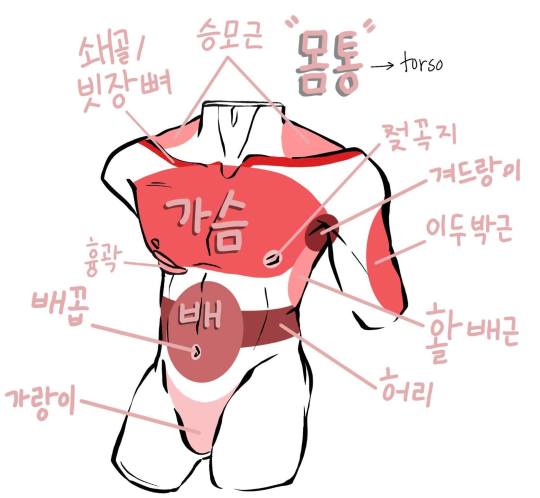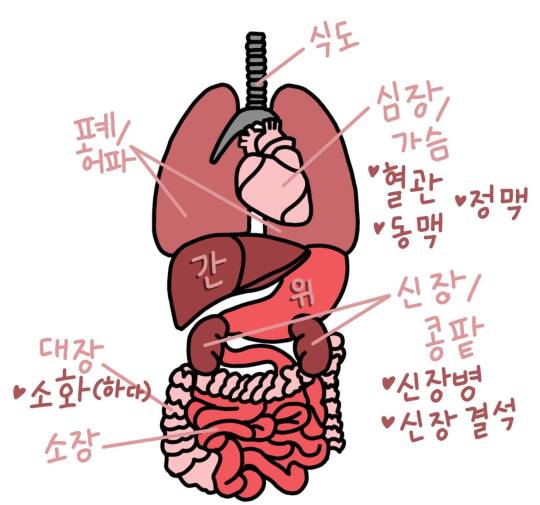#한국어 문법

— 어떤 행동을 제대로 하지 않음을 나타내는 표현.
A lot of people liked PART TWO a lot! Thank you for all your kind comments and praise! PART THREE will cover the skin and necessary vocabulary underneath. Enjoy <3

*picture is of a chest (half skeleton, half muscle) and a skull (necessary vocabulary is highlighted)
- 뼈대 - skeleton
- skeleton can also be translated as: 해골 and 골격
- major differences between 뼈대, 해골, and 골격: 뼈대 and 해골 are the most similar. Sometimes 해골 can refer to only the skull (see skull for a better understanding) - both of these refer to dead skeletons. However, 해골 comes from 한자 ‘骸骨’. The word 골격 also comes from 한자 meaning 骨格 (frame, figure) or 骨骼 (skeleton).
- 근육 - muscle
- 뼈 - bone
- 인대 - ligament
- 살 - flesh (not skin, but the ‘meaty-like’ part; almost like fat)
- 관절 - joint
- 두개골 / 해골 - skull
- major difference between 두개골 and 해골: both come from 한자 ( 두개골 = 頭蓋骨 // 해골 = 骸骨), however, 해골 (according to a Korean native speaker), refers to the picture of a skull. Whereas 두개골 refers to the actual, physical skull.
- 광대뼈 - cheekbone
- 아래턱뼈 - mandible (jaw)
- 코뼈 - nasal bone
Example Sentences:
- 다행히뼈에는 이상이 없나요 - Fortunately, there is nothing wrong with the bone(theboneis alright/not broken).
- 우리 오빠는 축구를 하다 인대가 늘어났어요 - My brother pulled a ligamentwhile playing soccer.

*picture is of an eye and a pair of lips with blemishes (necessary vocabulary is highlighted)
- 피부 - skin
- 여드름 - pimple / zit
- 기미 / 주근깨 - freckles
- major difference between 기미 and 주근깨: 기미 refers to spots you get from the sun (not usually pleasant) while 주근깨 translated to actual freckles
- 다래끼 - sty
- 수염 - facial hair (this can be a mustache or beard)
- 애교 살 - the fatty pocket under the eyes
- 다크서클 - dark circles
- 점 - mole, spot
- 흉터 / 흠 - a scar, blemish
- major difference between 흉터 and 흠: 흉터 refers to an actual scar made a long time ago whereas 흠 considers all types of blemishes or flaws on the skin
- not to be confused with 상처 (injury/wound that JUST happened) and 멍자국 (bruise)
- 입슬허피스 / 입슬의 발진 - cold-sore
- difference: 입슬허피스 = lip herpes VS 입슬의 발진 = lip rash
Example Sentences:
- 여드름을 짜다가 세균에 감염될 수도 있어요 - If you pop your pimples, you might spread germs.
- 저는 작녀에 얼굴에 있는 점들을 뺐어요 - I had a few molesremoved.
Extra Vocab to Know:
- 주름(살) - wrinkles / crease
- 혹 - bump / lump
- 땀 - sweat
- 눈곱 - sleep (the goop in your eye when you wake up; eye boogies)
- 하품(하다) - sigh (to sigh)
- 방귀 - fart
- 트림(하다) - burp (to burp)
- 소름 - goosebumps / goose pimples
- 딸꾹질(하다) - hiccup (to hiccup)
I received an ask last night asking about the word for ‘throat’. You could use 목 to describe your throat but a more technical term would be 목구멍. However, this isn’t used as often. For example:
목이 아프다 - a sore throat
희주는 눈물에 목이 메였다 - tears clogged Hee-Ju’s throat
Hope that clears up some confusion!
Happy Learning :)
~ SK101
As promised, here’s PART TWO of the in depth body vocab!PART ONEcovered the face / head. Today we will look at the back, torso, and most internal organs. Enjoy <3

*picture is of a male presenting torso (necessary vocabulary is highlighted)
- 몸통 - torso
- 승모근 - traps
- 쇄골 / 빗장뼈 - collar bone
- major difference between 쇄골 and 빗장뼈: Both can translate to the scientific name ‘clavicle’. However, 쇄골 comes from 한자: ‘鎖骨’.
- 흉곽 - ribcage
- 가슴 - chest / breast
- 젖꼭지 - nipple
- 겨드랑이 - armpit
- 겨드랑이 털 - armpit hair
- 이드박근 - bicep
- 배 - belly, stomach (exterior)
- 배꼽 - bellybutton
- 활배근 - lats
- 허리 - waist
- 가랑이 - crotch
Example Sentences:
- 저는겨드랑이에서 땀이 괴도하게 났었어요 - I used to sweat a lot in my armpits
- 밥을 많이 먹어서 배가 너무 불러요 - My stomachis full because I ate too much

*blank back cut off at the legs and neck (necessary vocabulary is highlighted)
- 등 - back
- 목 - neck
- 어깨 - shoulder
- 팔 - arm
- 왼팔 - left arm
- 오른팔 - right arm
- 양팔 - both arms
- 삼두근 - triceps
- 팔꿈치 - elbow
- 척추 - spine
- not to be confused with 척수 which refers to the spinal cord
- 허리 - waist
- 옆구리 - side
- 허리께 - hip
- 엉덩이 - butt / buttocks
Example Sentences:
- 양팔을 위로 줄 뻗어 보세요 - Please stretch your armsout
- 하루 종일 앉아 있었더니엉덩이가 아파요 - My butthurts from sitting on it all day

*picture of internal organs including the lungs, heart, liver, stomach, kidneys, and intestines (necessary vocabulary is highlighted)
- 장기 - organ
- 식도 - esophagus (’gullet’ in reference to animals)
- 폐 / 허파 - lung
- major difference between 폐 and 허파: 폐 is used in more medical contexts over 허파
- 심장 / 가슴 - heart
- major difference between 심장 and 가슴: 심장 refers to the literal pumping organ whereas 가슴 is the general area of the chest but can be used as an emotional heart (as opposed to 마음, which is the feeling in your heart)
- 혈관 - blood vessel
- 정맥 - vein
- 동맥 - artery
- 간 - liver
- 위 - stomach (internal)
- 신장 / 콩팥 - kidney
- major difference between 신장 and 콩팥: 신장 comes from 한자: ‘腎臟’, where 콩팥 is the native Korean version.
- 신장병 - kidney disease
- 신장 결석 - kidney stone
- 장 - intestine
- 대장 - large intestine
- 소장 - small intestine
- 소화 (하다) - digestion (to digest)
- 혈액 / 피 - blood
- major difference between 혈액 and 피: 혈액 is the medical form!
Example Sentences:
- 저는 수년간 위에 문제가 있어 왔어요 - I’ve had issues with my stomach for years
- 어젯밤 먹은 게 고화가 잘 안 돼요 - I’m having trouble digesting what I ate last night
Extra Vocab to Know:
- 배설(하다) - excretion (to excrete)
- 대변 / 똥 - stool or poop
- major difference between 대변 and 똥: 대변 is more like feces whereas 똥 is much more casual in speech
- 소변 / 오줌 - urine or pee
- major difference between 소변 / 오줌: same as above, 소변 is more like urine where 오줌 is more casual
- both 소변 and 대변 come from 한자: 大便 (대변) and 小便 (소변)
- 싸다 - to poop/pee
- 누다 - to poop
- 음경 - penis
- 자궁 - womb
This is obviously for educational purposes, so I hope tumblr lets it stay up. But here’s PART TWO of the in depth body vocab!
Happy Learning :)
~ SK101
품사 - Parts of Speech
Since my post from yesterday, I got a lot of requests to do more linguistic terms. I don’t think this is a comprehensive list, so if there’s any that you know that aren’t here, put it in the chat! Enjoy <3
♡ 자음 – consonant
ex. ㄱ, ㄷ, ㄴ, ㅅ, ㅇ
♡ 모음 – vowel
ex. 아, 어, 이, 애
Hangul [ x||x]
♡ 초성 – word-initial consonant
ex. ㅂ in 볶음
♡ 중성 – word-medial consonant
ex. ㄲ/ㅇ in 볶음
♡ 종성/ 받침 - word-final consonant (받침 literally means “support”)
ex. ㅁ in 볶음
♡ 글자 – letter
♡ 발음(하다) – pronunciation (to pronounce)
ex. 볶음 -> 보끔
♡ 예사소리/평음 – plain consonant (lit. ordinary sound/peaceful note)
ex. ㄱ, ㅂ, ㄷ, ㅅ, ㅈ
♡ 된소리/경음 – tense consonant (lit. Fortis sound/hard note)
ex. ㄲ, ㅃ, ㄸ, ㅆ, ㅉ
♡ 거센소리/격음 – aspirated consonant (lit. rough sound); 거센 from 거세다 (to be rough/violent)
ex. ㅋ, ㅍ, ㅌ, ㅊ
✿ 한국어를 배우는 외국인들은 된소리와 거센소리의 발음을 어려워한다. Foreigners learning Korean have a difficult time pronouncing tense and aspirated sounds.✿
♡ 복합어 – compound
ex. 물고기 (물 “water” + 고리 “meat”), 남자친구 (남자 “boy/man” + 친구 “friend”)
♡ 파생어 – derivative
ex. -관 (building – from 館); 영화 “movie” + -관 = 영화관 “theatre (lit. movie building)”
♡ 접두사 – prefix
ex. 되- (similar to “re-” prefix in English); 되- + 들다 “to enter” = 되들다 “to reenter”
♡ 접미사 – suffix
ex. -님 (polite title for someone older/you don’t know); 기사 “driver” + -님 = polite form to address the driver
♡ 어간 – stem
ex. 먹 from 먹다
♡ 어미 – ending
ex. -고 있다 (progressive tense); 먹다 + -고 있다 = 먹고 있다 “to be eating”
♡ 속어 – slang expression
♡ 숙어 – idiomatic expression
♡ 반의어 – antonym
♡ 유의어 – synonym
♡ 어원 – origin / etymology
♡ 예문 – example
♡ 용언 – a conjugated verb
More Parts of Speech - Related to the Sentence
♡ 명사 – noun
ex. 연필 “pencil”, 사람, “person”, 중국 “China”
♡ 대명사 – pronoun
ex. 나 “I/me (informal)”
♡ 수사 – numeral [go here]
♡ 동사 – verb [x || x || x]
자동사 – intransitive verb (cannot take a direct object)
타동사 – transitive verb (must take a direct object)
♡ 형용사 – adjective
ex. 예쁘다 “to be pretty”, 슬프다 “to be sad”
♡ 관형사 – determiner
ex. 이 “this”, 그 “that”, 저 “that over there”
♡ 부사 – adverb
ex. 나중에 “late”, 천천히 “slowly”
♡ 조사 – particle/postposition
ex. 은/는, 이/가, 을/를, 도, 에/에서
♡ 감탄사 – interjection
ex. 우와! “wow”, 아야 “ouch”, 대박 “amazing”, 헐 “omg”, 뭐라고?/뭐? “what?”
♡ 문법 – grammar
♡ 시제 – tense
ex. 과거 (시제) “past”, 현재 (시제) “present”, 미래 (시제) “future”
♡ 인칭 – person
ex. 1(일)인칭 (단수) “first person (singular)”, 3(삼)인칭 (복수) “third person (plural)”
♡ 구(문) – phrase [x || x || x || x]
♡ 절 – clause
♡ 문장 – sentence
♡ 주어 – subject
♡ 서술어 – predicate
♡ 목적어 – object
직접 목적어 – direct object
간접 목적어 – indirect object’
Hope this helped! Happy Learning :)
~ SK101
Post link

